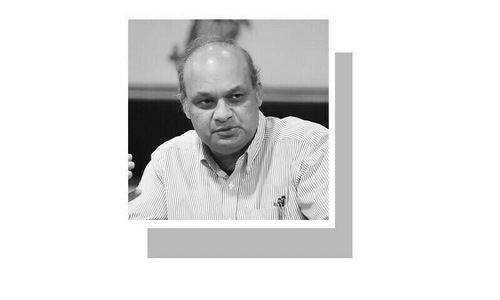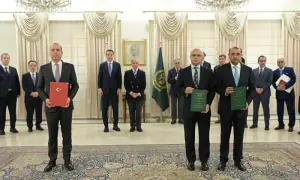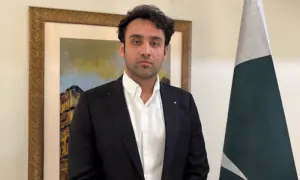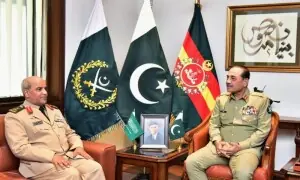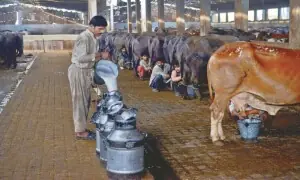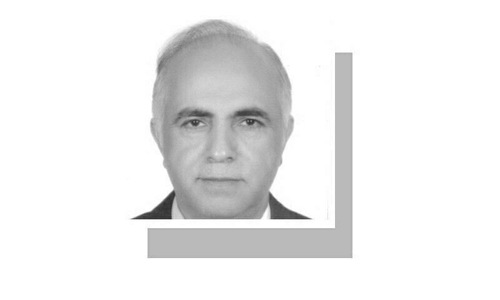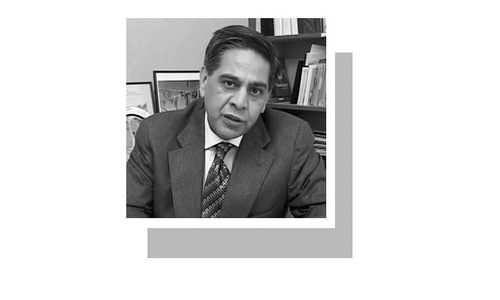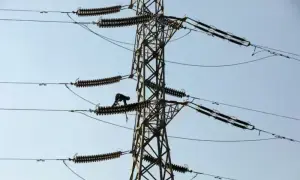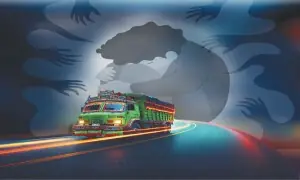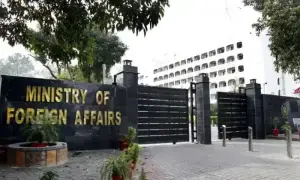A hollow political economy?
PRESIDENT Pervez Musharraf’s promise to a gathering of businessmen in Karachi for coming down heavy on the ‘miscreants’ planning to disrupt next month’s parliamentary elections, yet again carries a hollow ring.
At a time when the poorest of the poor have recently braved an atta shortage crisis, compounding the quality of their lives beyond the electricity shortages and mounting inflation, the challenge to the economy comes significantly more from its questionable handling by the government rather than the fallout from the mounting political challenge.
Mr Musharraf, in charge of Pakistan for more than eight years, appears eager to reassure nervous investors of his determination to ensure relative stability during a potentially turbulent election period.
It is difficult to predict exactly what emerges from a likely controversial national election, with opposition politicians already questioning the neutrality of the process, not to forget the neutrality of the present-day caretaker regime and the president’s own position.
Elections taking place not just after Benazir Bhutto’s assassination but indeed also after its chaotic fallout and the bloody violence following her tragic departure, will indeed be a high-risk game.
Mr Musharraf’s decision to open front after front since making the then Supreme Court Chief Justice Iftikhar Mohammad Chaudhry ‘non-functional’ in March, has only demolished his once established image of being politically above board and well-meaning. History has demonstrated time and again that the moral high ground once lost by a leader is seldom regained, unlike the possible reversal of territorial loss.
It is all too easy to describe the violence after Ms Bhutto’s death as nothing more than an emotional and frenzied response by angry demonstrators to a highly tragic event. Another way of looking at what instigated this violence may well be exactly what lies behind Pakistan’s increasing propensity for instability, fuelled by the way the economy has progressed in recent years.
Pundits in high places of economic thinking such as the mighty ministry of finance in Islamabad, may well be all too eager to claim success for overseeing a so-called bold economic recovery. Parameters such as rising liquid currency reserves and mounting economic growth rates have often been cited as supporting evidence. Added evidence has been drawn from quarters such as the privatisation ministry to reinforce the success story. It is undoubtedly true that there are more visible symbols of affluence in Pakistan today, ranging from many more luxury cars — including a few Rolls-Royce — to the large-scale proliferation of mobile cellular phones.
But anecdotal evidence suggests a number of equally profound gaps in this widely touted economic success story, with alarming linkages to Pakistan’s future political outlook. If the economic growth trends were ever calculated for individual provinces and districts within those provincial bounds, there is a good chance that parts of Punjab could emerge as the land of high hope and success against the rest of the country — with the possible exception of Karachi — being areas of despair, disorder and above all shrinking economic opportunities.
Another way of looking at this distorted picture may well be the number of those who remain below the poverty line. Even if the government’s estimates, which are not accepted by independent pundits, are taken for the record, at least a quarter of Pakistan’s population of at least 165 million live below the poverty line. The figure of more than 40 million Pakistanis living below the poverty line exceeds the size of the entire population of a number of countries around the world.
Faced with this distorted pattern of economic development, both across regions and among classes, it is not surprising that the worst manifestations of political turmoil of the kind seen recently in Pakistan, have taken place in the country’s non-Punjab regions, essentially the NWFP where militancy has spread to the settled regions, Balochistan where in the aftermath of Nawab Akbar Bugti’s killing it remains a recurring trend, and now, after Ms Bhutto’s assassination, the bloody violence in the interior parts of Sindh.
By contrast, it is not surprising that Punjab — the visibly fastest growing province of Pakistan — is also home to the largest community of pro-Musharraf politicians from the PML-Q.
The pattern of recurring violence seen in Pakistan recently underlines a fundamental and obvious point. People who do not see hope for a better future may be relatively more prone to joining waves of unrest and disorder.
In spite of the obvious connect between politics and Pakistan’s future economic challenges, there may be no immediate economic solutions to dealing with this profoundly complex issue. The effect of a set of economic choices followed over eight years under President Musharraf’s rule, cannot be undone in the potentially turbulent weeks or even months that lie ahead for Pakistan.
Without delicate handling, an election that lacks credibility will immediately evoke a possibly violent public response from Pakistan’s opposition leaders including some who would be encouraged to see more public response to their cause after the recent unrest in the country. If the government moves ahead in dealing a crushing blow to violent unrest as promised by President Musharraf, there is no guarantee that the situation will not aggravate further.
In the short term, the best option for the government must be all about setting the pace for a political transition which is fair, neutral, above board and, above all, free of bias in favour or against any individual or political group.
With official credibility already in tatters, it is difficult to imagine how President Musharraf can become a neutral arbiter of Pakistan’s national affairs, following a year in which his political battles appear to have primarily been about saving his own career as well as his self-created ruling order. Once the dust settles after the polls, a new Pakistani regime will have to quickly undo some of the worst legacies of economic policies in recent years. Diverting economic and developmental resources away from Punjab towards Pakistan’s impoverished regions may well be a key priority, all for the sake of preserving, protecting and promoting the cause of national unity.
In contrast to Pakistan’s economic picture under President Musharraf’s rule which has received a lift from US-led generous western support, there are huge gaps in the country’s economic structure. Areas such as the number of income taxpayers, staggering at less than one per cent of the population, say much about the failure to undertake structural reforms with long-term benefits.
Other distortions include the controversy surrounding public services such as government-owned hospitals and schools which present a pathetic picture which remains largely unchanged from the days preceding Mr Musharraf’s rule. Economic recovery may have indeed taken place if statistical evidence is taken as the guide. But the recovery is far from real when judged against the quality of life for average Pakistanis, especially those living in areas outside the economic heartland. The recent riots are just one of the many eye-openers to prove the point.
US climate policy after Bush
LAST month in Bali, as the talks on a new climate change treaty to replace the Kyoto accord reached a crisis point, the United States was actually booed by the delegates of more than 180 other countries at the conference. The Bush administration’s dogged refusal to accept any hard targets for reductions in greenhouse gas emissions had simply exhausted everybody else’s patience. But in less than a year there will be a new president, and then the US roadblock will be removed. Won’t it?
Hillary Clinton, Barack Obama and John Edwards, the three serious contenders for the Democratic presidential nomination, are all pledged to cut US emissions by 80 per cent from 1990 levels by the year 2050, and all three accept that this can only be achieved by legal caps on emissions. The leading Republican candidate, John McCain, makes the same promises, except that he is only aiming for 65 per cent cuts by 2050.
Now, you can argue that a presidential candidate who promises to deliver something in 2050 is not taking any risks, because the victor in this contest will be gone from the White House again by 2017 at the latest. Tell us what you’re going to do by 2015, and we’ll take you a lot more seriously. But it still marks a real and hopeful change in the world if the next US president accepts the need for both specific targets and emission caps.
As for the other Republican candidates, Mike Huckabee also supports emission caps, though he has not proposed any specific target for cuts. Mitt Romney has made no commitments at all, and pulled Massachusetts out of a regional deal to cut carbon dioxide emissions from power plants when he was governor. Rudy Giuliani isn’t even sure that there is any connection between human activities and global warming.
But the likelihood of any Republican candidate winning the 2008 presidential election, in the midst of what is shaping up to be a quite nasty recession, is small. Even now, McCain is the only one who consistently holds his own in the polls when he is matched against any of the three Democratic contenders. So we can probably assume that the next US president will be serious about climate change — but that does not automatically remove the roadblock.
None of the candidates has agreed to sign up to any climate change treaty that does not require the rapidly developing countries, above all China and India, to accept specific obligations too. George W. Bush used the exemptions for those countries in the Kyoto accord as an excuse for rejecting the whole process, but the demand that they make their own commitments to control emissions is strong and bipartisan in the United States.
In 1997 the US Senate passed the Byrd-Hagel Resolution, which declared that the United States should not sign any climate change treaty that does not also include binding targets and timetables for developing nations, by a 95-0 vote. When the then vice president, Al Gore, signed the Kyoto accord in 1998, he acknowledged that it would not be acted upon in the Senate until the developing nations also accepted targets and timetables — and nothing has really changed since then.
Why is this an American bottomline? Because the United States is the world’s greatest power, and almost every senior official and politician in Washington believes that it should stay that way forever.
It will not, of course. The rapid economic growth of the two Asian giants practically guarantees that the United States will be just one of the three great powers by mid-century, for economic strength is the source of most other forms of power. But it still makes a difference whether that happens in 2025 or 2045, especially to Americans.
Nobody in Washington is prepared to give the emerging great powers a free pass on emissions, because they are afraid that it would help them to catch up with the United States. Any climate change treaty that the US signs, even under an administration that takes the problem with the utmost seriousness, will have to respect that concern.The US position is not actually so distant from that of the other developed countries. Being less concerned to safeguard their relative positions in the pecking order, the Europeans, the Canadians and the Japanese were willing to let the developing countries have a 15-year free ride under the Kyoto accord. After all, the excess greenhouse gases in the atmosphere now were almost all emitted by the old industrialised countries — and back in 1997, they didn’t realise how urgent it was to make deep cuts in emissions.
But they always intended that the developing countries should accept a share of responsibility for future emissions under the follow-on treaty to Kyoto, which is the one now being negotiated. Not an equal share, of course, because they are still relatively poor and their per capita emissions are vastly less than those of the developed countries, but they cannot just let their emissions rip.
The post-Bush United States is not going to be a push-over on emission targets for developing countries, and it will have all the other industrial countries as its allies. There is just no point in France or Canada cutting their emissions if China’s and India’s are growing at 10 per cent a year.
The writer is a London-based independent journalist.
Which road did we take?
IN a page that could easily have come out of a Franz Kafka novel, Time magazine’s Simon Robinson says that a young man from the ministry of tourism recently accosted him at the departure lounge in a Pakistani airport. He insisted that Robinson provide his candid impressions of his stay in Pakistan by filling out a three-page survey so lessons could be drawn from the ministry’s campaign, ‘Destination Pakistan 2007’.
So Robinson wrote the following: “Rioting, looting, burning of shops and tyres along roads, shooting, general chaos, mayhem and insecurity.” Embarrassed, the young man responded by saying that the problems were caused by “only 10 per cent or 20 per cent of the people. The rest of us are very welcoming”.
But it is unlikely that the young man would have disagreed that 2007 was a disaster for Pakistan, probably the worst year since 1971. The disagreements begin when we talk about what caused the year to be so disastrous.
For a year that just ended, there should be no dispute about the facts. It is quite different from pondering far more distant events, such as what brought the Indus Valley civilisation to an end. But even though there is no disagreement about last year’s facts, there is plenty of disagreement about cause and effect. Two different theories of history compete for our attention. One supports military rule, or stratocracy, and the other one supports people’s rule, or democracy. For simplicity, let’s dub them Theories S and D.
Theory S argues that it was necessary to fire the Chief Justice because he was corrupt and out to derail the democratic process. It blames the attorneys for creating a mess which made the emergency inevitable. It argues that Musharraf acted in the national interest, not in his personal interest. Theory D argues that it was Musharraf’s political ambition to continue as president for another five years that set in motion the disastrous chain of events which began with the decision to suspend the Chief Justice.
This duel between competing theories of history is not unique to Pakistan. History, as the Dutch historian Pieter Geyl put it, is “an argument without end”.
As one stretches the conversation to the last eight years of Pakistani history, the disagreements multiply. While Musharraf would like to be remembered as a man who brought about remarkable economic progress, his opponents will remember him as someone who talked a lot about enlightened moderation and did precious little to contain the militancy.
Both theories agree on a few things. For example, both trace the militancy to the general’s famous U-turn on the Taliban in the wake of 9/11. When he turned the gun on the jihadis, they turned their guns on him. But then the two histories diverge.
Theory S argues that any other Pakistani leader, military or civilian, would have been compelled to make the U-turn, since they would all have been at the receiving end of Washington’s threat to comply or be bombed back to the Stone Age. Theory D argues that Musharraf caved in too easily and compromised Pakistan’s sovereignty.
The debate stretches on to the pre-Musharraf period. Theory S argues that the democratically-elected regimes that preceded Musharraf were strong proponents of the Taliban and of an aggressive, ‘forward’ policy on Kashmir. The goal was to bleed India and to tie down half of the Indian army in Kashmir. Some go as far as to blame Benazir Bhutto for being the ‘mother’ of the Taliban even though it is well known that when she came to power, the army told her that defence and foreign policy would be its exclusive preserve.
Both theories agree that that the current generation of militants is the direct descendant of the Mujahideen who drove the Soviets out of Afghanistan under General Zia. The four million Afghan refugees who spilled over into Pakistan brought with them not only a narco-Kalashnikov culture but one that was laced with the fire of radical religion.
But Theory S rejects the suggestion that either Zia or the military was responsible for this disastrous import. It argues that once the Soviets invaded Afghanistan, any Pakistani leader worth his or her salt would have complied with the US directive to launch a ‘holy war’ against the infidels.
The central thread in Theory S is that fate dealt Pakistan a weak hand right at its inception. In its rendition of history, the military was forced to seize power to prevent the country from becoming a pawn in the Great Game. Theory D, of course, sees the military as the villain, not the hero, in this epic struggle for survival.
A common thread of historical determinism runs through both theories, bringing to mind a verse from Shakespeare’s King Lear, “As flies to wanton boys, are we to the gods; they kill us for their sport.” But apart from this haunting similitude, the theories diverge from each other.
The situation is akin to that faced by a traveller, worn out by his travels, who looks back at two paths in a forest and cannot recall which one got him to the clearing where he has now halted for the night. Historical amnesia is not unique to Pakistan. Several examples are provided in E. H. Carr’s book, What is History? One of the 20th century’s most influential works, it is written in a lively conversational style, not the turgid prose of the academe.
Carr, a Trinity College fellow at Cambridge, saw history as a continuous “process of interaction between the historian and his facts, an unending dialogue between the present and the past”. He opined that there was no such thing as standalone facts but only facts that had been filtered by the mind of the historian. He said facts arose through “an a priori decision of the historian” to include them in his narrative. Facts were like a sack, which won’t stand up until ‘something’ is put in it. Carr reasoned that ‘something’ was the historian’s knowledge of the context and interpretation of events. He insisted, “The facts speak only when the historian calls on them”.
So, while historical events may be taken as given, Carr wrote that historical facts are derived within the process of narrative construction. In one of his most famous lines, he said that the “facts of history cannot be purely objective, since they become facts of history only by virtue of the significance attached to them by the historian”.
And so it is in Pakistan. Supporters of Theory S coexist with supporters of Theory D, each relying on the same facts to make a case respectively for benevolent dictatorship-in-uniform and representative rule through the ballot box.
Are the different strands likely to converge as time goes by? If the past is any guide, they will not. One is reminded of Zhou En-lai’s reply when he was asked about the impact of the French Revolution. The soft-spoken Mandarin simply noted that it was too early to know.
The writer, an economist specialising in defence and energy issues, is the author of “Rethinking the National Security of Pakistan”.
faruqui@pacbell.net
Judges under siege
CARRY a placard — “Release Justice Rana Bhagwandas” — and you will be thrown into the slammer. FIR No.13/08 lodged at the Clifton Town police station confirms the highhandedness of Musharraf’s despotic regime.
Justice Rana Bhagwandas started his judicial career as a civil judge at the age of 24. In 1994 he was elevated to the high court and then to the Supreme Court where he eventually became the senior-most judge, serving as Acting Chief Justice of Pakistan, whenever the Chief Justice was out of the country. He earned the reputation of hard work, dedication, clear thinking, impartiality and fairness. Upon retirement it has been the practice of the court to give the retiring judge a Full Court Reference, but in the building that now reminds one of the Supreme Court, traditions too have been banished.
On Nov 3, 2007, Justice Bhagwandas the senior-most judge of the Supreme Court was illegally incarcerated. After his retirement he was made a prisoner in his own home in Karachi. He caused offence because he did not break his oath to “preserve, protect and defend the Constitution of the Islamic Republic of Pakistan” when another was grinding his boot into it. “The people should fight for the law as for their city wall” (Heraclitus, 5th century BC).
Justice Bhagwandas during his meritorious career spanning 41 years, decided thousands of cases, yet for this great judge who did not prostrate before a dictator there was no justice. Citizens, however, wanted to honour him and express their gratitude. They assembled outside his residence, held candles and flowers, and called for his release. Amongst them were recently-married Salahuddin Ahmed, barrister-at-law, Asad Umar, chief executive of Engro Chemicals Pakistan Limited, and Kamran Noorani, owner of Pakistan Law House.
The ‘law enforcement agencies’ doing another’s bidding in vulturine fashion made off with the citizens. But infamy did not stop there. The candle, flowers and placard holders have been charged under Sections 147 and 148 of the Pakistan Penal Code (PPC) for “rioting” and “rioting armed with deadly weapon”. To constitute “rioting”, there must be force and violence (Section 146 PPC).
These conscientious citizens upon being convicted may be imprisoned for three years. Is this the republic that Mohammad Ali Jinnah wanted to create? “The idea was that we should have a state in which we could live and breathe as free men” (Quaid’s address to civil and military officers, Karachi, Oct 11, 1947). Instead, grovelling before the dictator and forced to accept the odious PCO oath of personal loyalty is the only guarantee to live and breathe freely.
The orders for lodging FIR No.13/08 must have come from the very top because Salahuddin Ahmed’s father is none other than Chief Justice Sabihuddin Ahmed, who has been prevented from carrying out his duties since Nov 3. Overnight the chief justice of the province is controlled by a foot constable. Light recedes, justice is eclipsed and darkness descends. The beast is born. “Law alone can give us freedom” (Goethe) and without it we are shackled.
The state itself violates the fundamental rights enshrined in the Constitution of Pakistan, including the right to “freedom of speech and expression” (Article 19), “freedom of assembly” (Article 16), the inviolability of the “dignity of man” (Article 14). Under Musharraf and his neutered caretakers anyone exercising his or her fundamental rights is liable to be arrested and imprisoned for a very long time. “When dictators and tyrants seek to destroy the freedoms of men, their first target is the legal profession and through it the rule of law.” (Leon Jaworski).
In Pakistan, the Constitution stipulates, that sovereignty “belongs to Almighty Allah alone” and “wherein the independence of the judiciary shall be fully secured”. A land “dedicated to the preservation of democracy achieved by the unremitting struggle against oppression and tyranny”. Abrogation and subversion of the Constitution is categorised as “high treason”.
Justice (adl o insaf) lies at the heart of Islam. Without justice, nations perish. Justice predates democracy and representative government. A candlelit vigil for the release of a judge who spent his entire life in the service of Pakistan is manufactured into a serious ‘crime’. This happened in the heart of the largest metropolis of Pakistan, and respectable members of society were targeted in the full glare of the media, but far worse treatment was meted out to people living away.
In interior Sindh, thousands of FIRs have been registered reportedly against half a million members of the Pakistan People’s Party. After the assassination of Benazir Bhutto the all-pervasive Police and Rangers disappeared for days, and advantage was taken by criminal elements. It now appears that this was done to help elect members of the quisling League.
FIRs have been lodged on the basis of ‘instructions from above’ and compliance made necessary to retain employment, but irreconcilable anomalies reveal the truth. Two representative examples put to rest the neutrality of the caretakers. The mukhtiarkar and the assistant mukhtiarkar both lodged FIRs (Nos.3/08 and 4/08) in respect of the very same incident against Abdul Jalil Memon, PPP’s candidate for PS 84.
FIRs against Haji Usman Jalbani, PPP’s candidate for PS 88, were lodged in four different police stations (Keti Bundar, Gora Bari, Garo and Gharo) pertaining to offences that took place at the same time, despite the fact that a day would be spent travelling between these areas. Coincidentally, six immediate family members of a caretaker minister are contesting on Q League tickets, including PS 84 and PS 88 constituencies.
Tainted self-seekers grasp their opportunity. Rather than apply salve to the raw wounds of the PPP, kerosene is sprinkled. People are being pushed towards intolerable injustices.
Constitution is the force which coalesces and forges the nation. An iron grip must stay the hand of the terrorist as he does not have the right to take life and because the Constitution mandates that “no person shall be deprived of life” (Article 9). Forced closure of CD and barber shops must be stopped because the Constitution grants every citizen the freedom of trade, business and profession (Article 18).
“Obedience to the Constitution is the inviolable obligation of every citizen wherever he may be and of every other person for the time being in Pakistan” (Article 5). But General Musharraf declared war on the Constitution and its custodians. The Taliban and the terrorists have followed suit. Until the Constitution and the judiciary are restored, terrorism, oppression, tyranny, injustice and anarchy will continue. Terrorists pierce the body. America’s trusted lieutenant whips the spirit. Pharaonic arrogance preserves the shell, mummified. A withered, shrivelled curiosity…
| © DAWN Group of Newspapers, 2008 |


